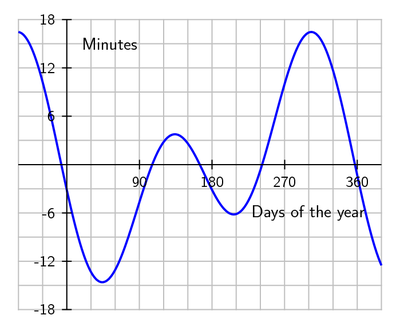 |
Department of Physics | User's Guide to the Night Sky |
Equation of Time
Our civil clocks are based on solar time and are designed such that when the Sun crosses the observer's meridian the time is about noon, i.e. 12:00. However the actual time that the Sun crosses the local meridian varies during the year by up to 16 minutes. This is to due to the elliptical nature of the Earth's orbit and the Earth's 23.5° axial tilt relative to the ecliptic. The difference between the time that Sun crosses the meridian and 12:00 as given by a civil clock is called the "Equation of Time". Below is the current curve.
A well-known consequence of the "Equation of Time" is the asymmetrical distribution of sunrise and sunset times. For northern hemisphere observers this is very apparent around the date of the winter solstice. The following table gives the Durham sunrise and sunset times in December and January :
Sunrise Sunset
1st December 8:08 15:43
6th December 8:16 15:40
13th December 8:24 15:38
20th December 8:29 15:40
27th December 8:32 15:45
2nd January 8:31 15:50
9th January 8:28 16:00
Hence by early January the evenings have become significantly lighter where the mornings remain at their darkest.
The following external links give further details on this phenomenon:
- Wikipedia Equation of time
- Nick Strobel's "Astronomy Without a Telescope" has a page on the Equation of Time
- M. Muller's article on Equation of Time
- Chapter 56 of Jean Meeus' Mathematical Astronomy Morsels has an excellent description.
| User's Page | jrl |
